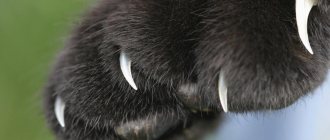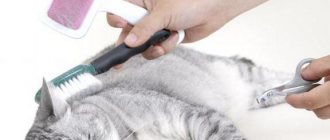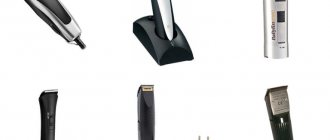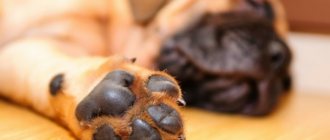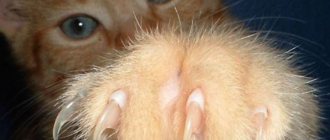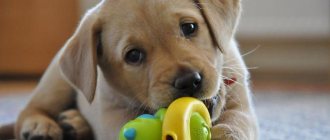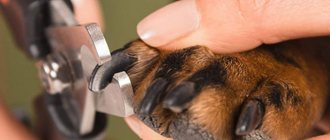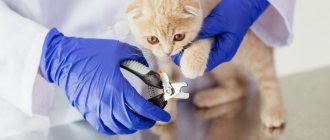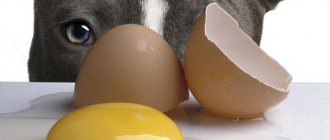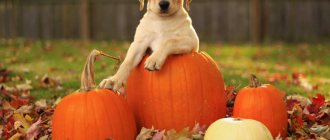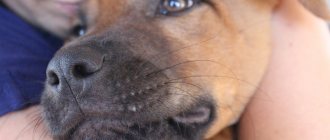- Firstly, overgrown claws prevent the animal from moving normally, prevent the correct placement of the paw, and cause a change in gait. For sports and show dogs, incorrect movements due to long nails, among other things, can lead to removal from the area or ring. In addition, if you step on the pad incompletely, additional stress is placed on the joints.
Secondly, excessively long claws bend and can grow into the paw pads. The animal feels severe pain, licks or chews the wound, as a result of which the paw becomes inflamed and lameness develops.
In addition, overgrown claws simply look ugly, and the dog gives the impression of being unkempt.
Nail trimming tools
To trim your Yorkshire Terrier's nails, you need to prepare everything you need in advance:
- The nail clipper is the main tool. It is sold in pet stores. It is better not to skimp on its quality, since it is purchased for many years.
- File - it is necessary to smooth out unevenness. It is convenient to use a non-traumatic glass file. You cannot use the same file to trim human nails and animal claws.
- A means to stop bleeding.
It is necessary to stop the bleeding when the “living part” of the claw is cut off and the vessel bleeds. This can be a hemostatic pencil or sponge, baking soda, corn starch, potassium permanganate. The pencil should be moistened with water and applied to the bleeding claw. A piece is cut off from the sponge and glued to the claw. These are the most convenient means to stop bleeding. If they are absent, the claw should be dipped in soda or starch for a couple of minutes until a lump forms. The lump will disintegrate on its own after the bleeding stops. Manganese must be used very carefully so as not to burn the dog. In general, this remedy is no longer popular due to the danger of poisoning.
If the owner does not know how to trim a Yorkie’s nails at home, he should contact a specialist in canine cosmetology – a groomer. The groomer will easily and quickly cope with the task and teach the dog’s owner to perform this simple manipulation.
Preparing the tools
To properly trim your Yorkie's nails, you should prepare all the necessary tools for the procedure. The most important thing is a nail clipper; you can buy it at a pet store. Manicure scissors are not suitable in this case; when using them, the claw crumbles, its delamination, and the formation of burrs occurs. The procedure for the dog turns into an execution.
A nail clipper should be chosen of the guillotine type; rubberized metal handles will prevent the tool from slipping in your hands. In addition to the nail clipper, you must have:
- nail file;
- alcohol or other antiseptic;
- cotton pads;
- hemostatic agent.
Important! You need to prepare in advance for the nail trimming procedure so as not to interrupt the process, making your dog nervous. Everything necessary for the procedure must be in a plastic box.
What will you need?
- Nail clipper , sold at any pet store, preferably “Guillotine” and always in NORMAL size. The idea that everything should be small for a small dog does not hold true in this case. Trying to cut the nails of a squirming Yorkshire terrier with a microscopic nail clipper will make you tired of it in exactly 3 seconds.
- Cotton buds
- Dry potassium permanganate , so that if something irreparable happens (ha-ha) and you touch the living part of the nail (oh-horror!), cauterize the vessel and the claw will not bleed.
Now about how to trim “correct” and “incorrect” claws
“Irregular” claws should be cut either close to the living layer, or slightly gripping it, fig. 2 . Don't be afraid of slight bleeding, just cauterize the nail with dry potassium permanganate using a cotton swab. If you trim the claws in this way often enough, the living part will begin to shrink and gradually return to normal, Fig. 4
If the “wrong” claws are very long, you need to cut the nail to normal length without paying attention to the living part. Immediately burn each nail with potassium permanganate so that it does not bleed, fig. 3 It is often mentally difficult for owners to do this, and the first few times, until the living part becomes shorter, it is worth contacting a veterinarian or groomer. As in the previous case, the living part will return to normal over time, and cutting your nails will not cause any problems.
Normal Yorkshire Terrier nails are easy to trim and are absolutely painless for the dog. Using a nail cutter, cut off the tip of the claw, flush with the paw pad, at an angle of 45 degrees, Fig. 5 . If the nail is light-colored and the living part is visible in the light, the remaining nails are cut off in the same way. A Yorkshire Terrier needs to trim its nails 1-2 times a month . Don't forget to cut your fingernails too.
The nail is of normal length - short, does not reach the floor, the dog does not “click” its claws, Fig. 6
Why trim your Yorkie's nails?
Claws are trimmed not only for reasons of beauty, but also for safety reasons.
- Firstly, overgrown claws prevent the animal from moving normally, prevent the correct placement of the paw, and cause a change in gait. For sports and show dogs, incorrect movements due to long nails, among other things, can lead to removal from the area or ring. In addition, if you step on the pad incompletely, additional stress is placed on the joints.
- Secondly, excessively long claws bend and can grow into the paw pads. The animal feels severe pain, licks or chews the wound, as a result of which the paw becomes inflamed and lameness develops.
- Thirdly, the claw delaminates and clings to the floor covering, grass, and uneven asphalt. When running or jumping, a dog can tear off a claw, causing bleeding and serious damage to the paw. Such a wound is easily infected and difficult to treat.
How to cut a Yorkshire Terrier's nails
In order to trim the nails of a Yorkshire Terrier correctly and fearlessly, you need to understand how this claw works. Figure 2 shows the structure of the “wrong” nail - the thin living part has grown along the entire length of the nail, the claw is very long and the paw pads reach the floor only with the back part, the dog’s center of gravity is shifted and the joints do not work correctly.
Yorkshire Terrier coat care
No breed can boast such a magnificent coat as the Yorkshire Terrier. But a Yorkie will look like this only if this coat is regularly and properly cared for. The Yorkshire's coat develops gradually and changes in texture and color as it matures. The final color is established by 15-24 months.
Nail trimming is one of the important hygiene procedures that dogs usually do not like.
It must be carried out every two weeks if the dog walks on the street and has the opportunity to grind its claws on the asphalt, and every week if the pet does not go outside or goes out but does not step on the asphalt. In general, to understand how often to trim your Yorkie’s nails, you should listen to his steps. If the claws make a characteristic clicking sound on the floor, it’s time to trim them.
It is recommended to carry out an extraordinary haircut before an exhibition or sports competition so that the dog’s paws look neat and well-groomed.
You also need to trim the bitch's claws before giving birth to prevent her from scratching the newborns.
Nail trimming is the first step in caring for your dog’s paws. The second stage is cutting the hair between the toes, and the third is trimming the hair on the paws to floor level.
How to litter train a Yorkshire Terrier puppy.
Everyone knows that a baby Yorkshire terrier who has not been vaccinated cannot walk on the street, and he has to be toilet trained at home in a diaper or in a litter tray. All veterinarians and breeders constantly hear the question: “ How to toilet train a puppy?” ". There is nothing complicated about this, all you need is your patience and perseverance!
How to cut your Yorkie's hair yourself - step-by-step instructions
When purchasing a Yorkshire Terrier for a home, the future owner must be aware that the long, well-groomed coat requires complex, regular care. Finding a groomer who will tidy up your pet's guard hair is not difficult, but regular care for a Yorkshire Terrier requires regular visits to the salon, which cost a lot of money.
It is necessary to accustom a Yorkie to grooming manipulations and constant care from puppyhood - in the future, it will be much easier to cope with an adult dog if the dog knows and is not afraid of the procedures.
Usually a puppy appears in a new home at about 1.5 - 2 months. By this age, the breeder must show the puppy what washing and combing its fur means. After the baby arrives in a new place, he needs to be given time to get used to it - you can’t even carry out hygienic care right away. At least 2-3 weeks after the dog appears in the family, you can accustom the puppy to hygiene procedures - trimming nails, combing hair, cleaning ears and face. A small dog quickly gets accustomed to new things and easily tolerates procedures.
Types and frequency of haircuts
The Yorkshire Terrier's long, soft coat grows constantly and does not shed. These dogs require careful attention and professional guard hair care.
Even if the owner is sure that he can cut the Yorkie’s hair on his own, it is better to turn to a professional, observe how to properly restrain the dog, how to properly work with tools, and directly cut the dog’s hair. It is also recommended to study the educational material on caring for the Yorkshire Terrier's coat.
Most grooming salons offer a home service - to reduce stress for the pet, all procedures are carried out in the familiar territory. Having a groomer come to your home will cost the owner a pretty penny, but a specialist will help the owner decide on the tools and various cutting methods.
Of course, if the dog has an exhibition career, it is better to entrust the care of the pet to a professional - even for a sloppy “hairstyle” or not meeting the standard, the judges will reduce points at the exhibition. The breed appearance of the show Yorkie is long, well-groomed hair; it is almost impossible to cope with a task of this magnitude on your own.
Grooming salon service options:
- Hygienic haircut. It consists of processing the length, without shaping hairstyles. Excess fur is removed from the paws, face and ears, armpits, groin, and anal area. Hygienic dog care includes trimming or trimming nails, cleaning ears, and washing eyes. The frequency of hygiene procedures is approximately once every 2 weeks.
- Standard haircut. Suitable for dogs participating in exhibitions. The breed standard provides for a strict appearance - only one type of “hairstyle”. Standard coat treatment is carried out before each exhibition or once every 2-3 months.
- Fantasy haircuts. The appearance of a pet depends only on the wishes or imagination of the owner. The coat can be long or completely short, you can make drawings on the animal’s body (the so-called hair tattoo), tie various braids or ponytails. Such “hairstyles” are done as the animal grows overgrown. The patterns on the body are overgrown in 2-3 weeks, after which new ones can be made again. Also, groomers offer a service for dyeing dog hair in different colors - it looks funny.
- Summer haircut. This type is absolutely not suitable for dogs participating in exhibitions. If the pet does not have breeding value or is not engaged in a show career, to increase comfort in the summer, the dogs are cut almost bald, leaving a little hair in the area of the muzzle, paws, and tail (but often cutting off the hair from the entire body except the head). Usually the dog is cut this way by the beginning of summer, and closer to autumn the dog grows hair to a standard length.
Features of haircuts for boys and girls
Haircuts differ depending on the gender of the dog. Girls are often left with a “skirt” and long bangs, which are collected in a ponytail (braided), tied with hairpins or elastic bands.
To design a “skirt,” the top of the body—the back and sides—is cut very short with a clipper, leaving hair on the tail and belly, which is formed like a skirt. The bangs should remain long, and the rest of the fur on the face should be cut short.
A haircut for boys is done in the shape of panties. The entire body of a Yorkie boy is clipped short, leaving “pants” on the paws and tail. At the owner's request, the groomer leaves an elongated beard - the hairs on the face are 2 - 3 centimeters longer than the main coat.
Why trim between the paw pads?
There are dog breeders who are sure that there is nothing superfluous in nature. If hair grows between the pads, it means it is necessary to protect the paws. Therefore, they do not cut the wool so that it protects the animals’ feet from thorns, sharp stones and other surprises on the ground surface. But in reality, everything happens the other way around and the opinion of experts regarding whether dogs need to be cut between the pads of their paws is completely opposite. All veterinarians and groomers claim that this approach is fundamentally wrong, since not only does it not help, but can even harm the pet. Therefore, such a procedure should be mandatory.
Important! Owners of dogs of all breeds should regularly check the condition of the interdigital spaces and paw pads. And owners of long-haired breeds additionally need to cut the hair in these places, as well as around the feet, following the general cutting style.
During the inspection, you need to check whether there are any thorns or splinters in the pads or between them, or whether resin or chewing gum has stuck. If foreign objects are found, they must be carefully removed or carefully cut off along with the fur. In addition, in the interdigital space with untrimmed hair, tangles can form, which further aggravate the situation and require mandatory cutting. If you regularly trim your dogs between their paw pads, you can easily prevent all of these problems.
The difference between trimmed and untrimmed paws is especially noticeable in cases where the dog has to walk on insufficiently equipped areas. Asphalt, fuel oil or other resinous substances heated in the sun stick to the hairs and subsequently prevent the animal from walking normally. In winter, roads are sprinkled with salt and reagents, which irritate dogs’ feet, especially if they remain on them for a long time, absorbed into the long hair.
The accumulation of dirt, tangles, and especially harmful chemicals between the pads and fingers can cause the development of allergic reactions and other diseases. As a result, the animal becomes nervous, restless, and begins to chew out the hair on its paws on its own in order to get rid of the discomfort.
But even when the dog walks on a smooth surface, trimming the toes and pads is also necessary so that the pet does not slip and its paws are positioned correctly. On slippery floors, shaggy feet can lead to serious injuries, such as hip or kneecap dislocations.
In any case, neglected dog paws covered in tangles and dirt can ruin the appearance of even the most beautiful and well-groomed dog. At the same time, it will simply be painful for her to walk, which will negatively affect the well-being of the pet itself and the mood of the owner.
Haircutting tools
For high-quality hair processing, like in a salon, you will need a set of tools and devices. Buying all the necessary grooming supplies to care for your pet will not be cheap, but regular grooming of your dog will quickly pay for the cost of the equipment.
The minimum kit for home grooming includes:
- Rubber mat. An ordinary bath mat will do - it is needed for the dog’s comfort so that the paws do not slip during the procedure. If possible, it is better to purchase a special table for grooming, with a stand for securing the animal with a leash.
- An electric machine with attachments, and a trimmer is also a must. The clipper, as well as the set of attachments, must be metal - the plastic becomes electrified, knocks off the hair, and the haircut will turn out sloppy. Plastic attachments clog quickly - the equipment will not last long. A trimmer is needed to treat especially delicate areas on the face, ears, and anus.
- Metal combs.
- Scissors of various shapes and lengths: straight, curved, with rounded tips for cutting on the muzzle or under the tail.
- A special device for untangling matted wool is a tangle cutter.
- Nippers (guillotine) for cutting claws, a file for trimming the sharp tips of the claw.
Step-by-step instructions: cutting hair at home
Before trimming a Yorkie at home, the animal owner needs to prepare himself: clothes should not be made of synthetic fabrics. The thin fur of a Yorkie quickly becomes electrified, so for hygiene procedures you need to choose a cotton suit.
Before cutting, it is recommended to wash the dog, and after all the procedures, rinse the fur again to wash off the remnants of the cut hair.
After the dog is washed and the coat is dried, you need to thoroughly comb the pet. If there is stray hair or tangles, they must be removed with a tangle cutter.
You need to make an even parting along the dog’s back and comb the fur on both sides. The ends are aligned to the same length, the chest and throat are cut to the lower jaw.
After the body shape is formed, the muzzle and ears are trimmed. The ears should have the shape of a triangle with sharp corners and protrude evenly and clearly on the head.
The length is removed under the tail using small scissors. The groin, paws and armpits are trimmed with a machine or trimmer, leaving a length of no more than 5 mm.
Hygienic haircut for Yorkie
A hygienic haircut is done approximately once every 2 weeks, as the fur and claws grow.
The fur is carefully trimmed with scissors along the edges of the ears, on top, around the eyes and in the groin. The anus and the area around it are trimmed with small scissors with rounded tips. The hairs in the ears are trimmed with a trimmer.
Standard haircut
The Yorkshire Terrier's "hairstyle" must meet a certain standard; this is a mandatory procedure for dogs taking part in exhibitions or having breeding value. This haircut emphasizes all the advantages of the dog. This is usually done in addition to hygienic, and can be of two types:
- Pants - a haircut that evens out the length.
- Flare – not only the length of the coat is straightened, but in addition the upper 2/3 of the entire length is cut.
To perform these haircuts, start working with the machine, processing the back and tail. The muzzle is cut fairly short with scissors with rounded ends. The result should be the shape of a hat. The tail is cut with a brush, or like a broom.
Trim paws
Paw trimming is a mandatory procedure, both for hygienic care and for other types of care for the Yorkshire Terrier.
Before you start processing the fur on the paws, you need to trim the claws. The nail plate is cut with a nail clipper at a natural grinding angle. The sharp edge, if there is one, the cut ends of the claw must be filed off with a file. It is best to trim the nails after bathing the dog, when the plate is softened - it will not flake.
After trimming the nails, you need to trim the hair between the toes and paw pads. This procedure is done with a machine or trimmer to a length of 5 mm. When grooming, you need to securely hold the dog so as not to damage the delicate skin of the paw pads.
What you need to know for this
The best decision would be to entrust your pet to a veterinarian or professional groomer. Nails need to be trimmed at least once every three to four weeks. It all depends on the individual characteristics and conditions of keeping the dog. Unfortunately, not everyone and not always have such an opportunity. But, you can learn to do it yourself at home. Although the procedure requires preparation and some knowledge, it is actually simple. Ask your veterinarian to explain to you all the features of cutting and show you exactly how it is done. Once or twice will be enough. You will learn how to trim nails correctly and understand how to behave with your dog during the procedure.
If you decide not to resort to outside help even for the first time, carefully prepare for the procedure. First, you need to learn how claws are structured, how they grow, and how to properly trim a dog’s large nails with a special nail clipper.
Claws are not just a keratinized part of the body. Unlike human nails, they have a large blood vessel. Its peculiarity is that it grows along with the claw. And the longer you don’t cut them, the longer and closer to the tip it will be. When the claws are regularly shortened, the vessel also contracts. You can clearly see it in cats. With dogs it’s a little more complicated - in light-colored claws you can see a dark red tube, in black claws it is completely invisible. You need to cut the claw 2-3 mm lower than where the vessel is visible, as it may turn out to be longer than it seems at first glance. Therefore, black claws will have to be cut very little at a time, no more than 1 mm at a time, constantly checking whether the claw has lightened and whether you have gotten close to the vessel.
How to accustom a dog to the procedure
You need to accustom your pet to trimming its nails from an early age. Over time, the dog will get used to the manipulations, will not be afraid of them, and it will take you a minimum of time. If the dog is not familiar with the procedure and does not understand what you want from it, it may become nervous, break out, and show aggression.
Preparation
Trimming your dog's nails at home should be taken very seriously. Improper actions can cause harm, both physical and mental.
A few days before you plan to do grooming, begin to establish tactile contact with your pet. Teach him not to be afraid of your touching his paws and pads. Several times a day, squat down next to your dog so that you are at approximately the same level with him. Stroke the paws, pick them up during play, touch the pads and claws. The dog should not feel threatened by such touches.
Choose a moment when the animal is calm, well-fed and satisfied. Before you start trimming the nails, you need to satisfy all the needs of the pet - take it for a walk. A dog that is tired after a walk will react more calmly. This is especially true for active breeds and puppies. Try to provide a comfortable environment for the dog, pet it, talk, calm it down, and only then proceed directly to the procedure.
How to trim a dog's nails at home
You can start with one or two claws a day. Prepare in advance and be sure to disinfect the tool so that it is ready to hand. It’s good if your pet has the opportunity to get to know him in advance, sniff him and examine him. Only after this can you proceed directly to the procedure:
- When interacting with your dog, take its paw in your hand, hold it firmly, but not too tightly - you should not hurt the dog or make it feel threatened by violent action on your part. Use your thumb and forefinger to secure the dog's finger on which you are going to cut the claw, and apply light pressure.
- Try not to touch the area between your dog's toes. She might not like it.
- Disinfect nails to avoid infection in case of unexpected complications during cutting.
- Determine the approximate length that needs to be cut. Do not hurry. It's better to cut a little less than you need. This way you will be absolutely sure that you will not damage the blood vessel. Cut off the folded part first. An almost correct, lighter oval shape of the cut will mean that the living part is located further and it is no longer possible .
- Take the tool and with one precise, short press, cut the required length.
- It is necessary to cut at an angle of 45° from top to bottom. To avoid delamination and creases, always cut perpendicular to the growth line, trying to avoid sharp corners.
- Process the cut first with a large file and, if necessary, with a fine sanding file.
- If the dog remains calm, you can continue the procedure. If your pet gets nervous, gets scared, or starts to struggle, let him go and try to calm him down. Talk to him kindly and offer him some treat. Try to continue.
- It is more convenient to trim the nails on the hind legs when the dog is lying down. Place her on a covered table or sofa and have someone hold her.
The animal should know that after the procedure there will definitely be a reward in the form of a favorite treat or game.
It's okay if you trim one nail a day at first. Next time, perhaps, it will be possible to trim 2-3 at a time. The dog will get used to it over time, and the whole procedure will take about 10 minutes. The main thing is that your pet completely trusts you, and that he does not associate the procedure with pain and fear.
